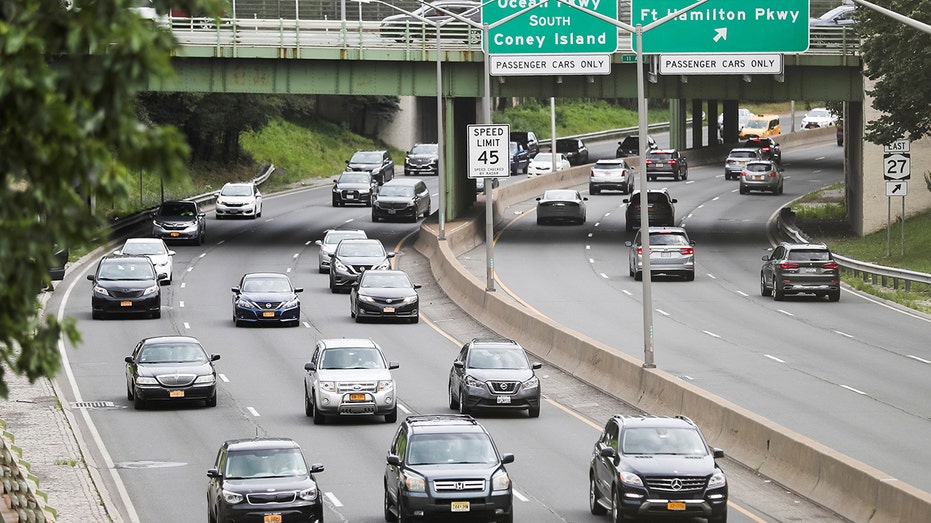CBO offers Congress options for saving Social Security, Medicare, Highway Trust Fund from insolvency
Options highlighted include tax increases and spending reforms
Biden's proposals undermine social security: Scalise
Rep. Steve Scalise, R-La., calls out President Biden's economic policies on 'Kudlow.'
The Congressional Budget Office (CBO) recently released a pair of reports offering options for reducing the federal budget deficit that could provide a roadmap for lawmakers to save Social Security, Medicare and the Highway Trust Fund from becoming insolvent over the next decade.
According to CBO's projections from last year, the three major trust funds will be tapped out over the next 10 years – the Highway Trust Fund will be exhausted in 2027, Medicare's Hospital Insurance Trust Fund in 2030, and Social Security's Old-Age and Survivors Insurance Trust Fund in 2033. Updated estimates will likely be provided in the weeks ahead as the CBO releases new budget forecasts.
Once those trust funds are exhausted, the programs they help finance will have to rely solely on incoming tax revenue and reduce spending unless Congress takes action as it has in the past to shore up the trust funds. If the trust funds become insolvent, Social Security benefits would be cut by a projected 23%, Medicare's hospital spending by 10%, and highway spending by 45%.
BIPARTISAN TRUST ACT AIMS TO SHORE UP SOCIAL SECURITY, MEDICARE, HIGHWAY TRUST FUNDS

Social Security is projected to reach exhaustion in 2033, joining Medicare and the Highway Trust Fund on a path to depletion unless Congress acts. (istock / iStock)
The CBO's reports on large and small options for deficit reduction were compiled by the nonpartisan Center for a Responsible Federal Budget (CRFB) into a report that identified a number of ways to increase tax revenue and decrease or reform spending over the next decade to extend the solvency of the endangered trust funds. Here's a look some of the notable options presented to close the budget gaps:
Medicare Hospital Insurance Trust Fund
Also known as Medicare Part A, the Medicare Hospital Insurance (HI) Trust Fund's insolvency looms in 2030 but could be extended through the following policies identified by CBO and CRFB:
- Imposing a payroll tax of 1% on Americans' earnings would yield an estimated $1.136 trillion in revenue and more than cover the trust fund's 2032 solvency gap – closing 213% of the forecasted gap.
- Expanding the base of the Net Investment Income tax would bring in $249 billion in revenue and close 40% of the Medicare HI Trust Fund's 2032 gap.
- Reducing Medicare Advantage benchmarks by 10% would save $392 billion and cut the 2032 funding gap by about 44%.
- Restricting the use of Medigap insurance would save $100 billion and close about 13% of the 2032 gap.
- Consolidating the Graduate Medical Education (GME) program's payments could close about one-fifth, with about $81 billion in savings from indexing it to the consumer price index (CPI) minus 1% sufficient to close 21% of the gap, versus $68 billion and a 13% reduction of the gap if GME was just indexed to CPI.
MAJOR SOCIAL SECURITY TRUST FUNDS COULD BE TAPPED OUT BY 2033: CBO

Medicare's Hospital Insurance Trust Fund is projected to be tapped out in 2030. (AP Photo/Pablo Martinez Monsivais, File / AP Newsroom)
Social Security Trust Fund
The projected insolvency of Social Security's Old-Age and Survivors Insurance Trust Fund in 2033 could be delayed through the following policy options analyzed by CBO and CRFB:
- Eliminating the taxable maximum above $250,000 of wages would yield over $1.2 trillion in additional tax revenue over a decade – enough to close 42% of the 2032 gap.
- Increasing the taxable maximum to cover 90% of wages would bring in $670 billion in tax revenue and shrink the 2032 gap by 20%.
- Including all newly hired state and local government workers in Social Security, and thus subjecting them to payroll taxes, would bring in $132 billion in revenue and shrink the 2032 gap by 5% – a figure that would decrease over time as they begin to draw benefits.
- Using chained CPI to index the Social Security cost-of-living adjustments (COLAs) would save $175 billion over a decade and close 9% of the 2032 gap.
- Raising the full retirement age by two months per year to 70 would save $121 billion and close 10% of the 2032 gap.
Adopting a flat benefit between 125% and 150% of the federal poverty line (FPL) would close about one-third of the 2032 gap and fully restore Social Security's solvency over the next 75 years:
- A flat benefit at 125% of FPL would save $593 billion over a decade and close 39% of the 2032 gap and 118% of the 75-year gap.
- A flat benefit at 150% of FPL would save $270 billion over a decade, close 19% of the 2032 gap, and 88% of the 75-year gap.

The Highway Trust Fund is projected to be exhausted in 2027. (Reuters/Eduardo Munoz / Reuters Photos)
Highway Trust Fund
The exhaustion of the Highway Trust Fund is projected to occur in 2027 but could be pushed back with the following reforms identified by CBO and CRFB:
- Raising taxes on gas and diesel by 15 cents per gallon and indexing them to inflation would bring in $240 billion in revenue and shrink the 2032 gap by 84%.
- Enacting a carbon tax of $25 per metric ton with 5% real growth would bring in $865 billion in revenue over a decade and close 62% of the 2032 gap.
- Enacting a $25 per metric ton carbon tax with 2% real growth would generate $769 billion in revenue and close 49% of the 2032 gap.
- Repealing the Davis-Bacon Act, which requires federally-funded projects to pay a locally prevailing wage, would save about $17 billion and close 2% of the 2032 gap.
GET FOX BUSINESS ON THE GO BY CLICKING HERE
Could Social Security face insolvency by 2035?
Missouri Rep. Jason Smith reacts to Biden aides reportedly discovering a second batch of mishandled classified documents and Social Security possibly facing insolvency on 'The Evening Edit.'





















